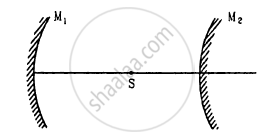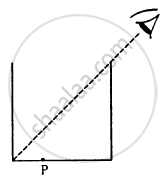Advertisements
Advertisements
Question
k transparent slabs are arranged one over another. The refractive indices of the slabs are μ1, μ2, μ3, ... μk and the thicknesses are t1 t2, t3, ... tk. An object is seen through this combination with nearly perpendicular light. Find the equivalent refractive index of the system which will allow the image to be formed at the same place.
Solution
k number of transparent slabs are arranged one over the other.
Refractive indices of the slabs = μ1, μ2, μ3, ..., μk
Thickness of the slabs = t1, t2, t3,.., tk
Shift due to one slab: \[∆ t = \left[ 1 - \frac{1}{\mu} \right]t\]
For the combination of multiple slabs, the shift is given by,
\[∆ t = \left[ 1 - \frac{1}{\mu_1} \right] t_1 + \left[ 1 - \frac{1}{\mu_2} \right] t_2 + . . . + \left[ 1 - \frac{1}{\mu_k} \right] t_k . . . (i)\]|
Let μ be the refractive index of the combination of slabs.
The image is formed at the same place.
So, the shift will be:
\[\Delta t = \left[ 1 - \left( \frac{1}{\mu} \right) \right]( t_1 + t_2 . . . + t_k ) . . . (ii)\]
Equating (i) and (ii), we get:
\[\left[ 1 - \left( \frac{1}{\mu} \right) \right]( t_1 + t_2 . . . + t_k ) = \left[ 1 - \frac{1}{\mu_1} \right] t_1 + \left[ 1 - \frac{1}{\mu_2} \right] t_2 + \left[ 1 - \frac{1}{\mu_k} \right] t_k \]
\[ = ( t_1 + t_2 . . . + t_k ) - \left( \frac{t_1}{\mu_1} + \frac{t_2}{\mu_2} + \frac{t_k}{\mu_k} \right)\]
\[ = - \frac{1}{\mu} \sum^k_{i = 1} t_i = - \sum^k_{i = 1} \left( \frac{t_i}{\mu_i} \right)\]
\[ \Rightarrow \mu = \frac{\sum^k_{i = 1} t_i}{- \sum^k_{i = 1} \left( \frac{t_i}{\mu_i} \right)}\]
Hence, the required equivalent refractive index is
\[\frac{\sum^k_{i = 1} t_i}{\sum^k_{i = 1} \left( \frac{t_i}{\mu_i} \right)}\]
APPEARS IN
RELATED QUESTIONS
Why does unpolarised light from a source show a variation in intensity when viewed through a polaroid which is rotated?
Describe briefly using a diagram how sunlight is polarised ?
A parallel beam of light is incident on a converging lens parallel to its principal axis. As one moves away from the lens on the other side on its principal axis, the intensity of light
A concave mirror having a radius of curvature 40 cm is placed in front of an illuminated point source at a distance of 30 cm from it. Find the location of the image.
A concave mirror forms an image of 20 cm high object on a screen placed 5.0 m away from the mirror. The height of the image is 50 cm. Find the focal length of the mirror and the distance between the mirror and the object.
A concave mirror has a focal length of 20 cm. Find the position or positions of an object for which the image-size is double of the object-size.
A candle flame 1.6 cm high is imaged in a ball bearing of diameter 0.4 cm. If the ball bearing is 20 cm away from the flame, find the location and the height of the image.
A converging mirror M1, a point source S and a diverging mirror M2 are arranged as shown in figure. The source is placed at a distance of 30 cm from M1. The focal length of each of the mirrors is 20 cm. Consider only the images formed by a maximum of two reflections. It is found that one image is formed on the source itself. (a) Find the distance between the two mirrors. (b) Find the location of the image formed by the single reflection from M2.

A cylindrical vessel, whose diameter and height both are equal to 30 cm, is placed on a horizontal surface and a small particle P is placed in it at a distance of 5.0 cm from the centre. An eye is placed at a position such that the edge of the bottom is just visible (see figure). The particle P is in the plane of drawing. Up to what minimum height should water be poured in the vessel to make the particle P visible?

Light is incident from glass (μ = 1.50) to water (μ = 1.33). Find the range of the angle of deviation for which there are two angles of incidence.
A container contains water up to a height of 20 cm and there is a point source at the centre of the bottom of the container. A rubber ring of radius r floats centrally on the water. The ceiling of the room is 2.0 m above the water surface. (a) Find the radius of the shadow of the ring formed on the ceiling if r = 15 cm. (b) Find the maximum value of r for which the shadow of the ring is formed on the ceiling. Refractive index of water = 4/3.
One end of a cylindrical glass rod (μ = 1.5) of radius 1.0 cm is rounded in the shape of a hemisphere. The rod is immersed in water (μ = 4/3) and an object is placed in the water along the axis of the rod at a distance of 8.0 cm from the rounded edge. Locate the image of the object.
Answer the following question in detail.
State the conditions under which a rainbow can be seen.
Pick the wrong answer in the context with rainbow.
A plano-convex lens is made of material having refractive index 1.5. The radius of curvature of curved surface is 40 cm. The focal length of the lens is ____________ cm.
Explain the formation of primary and secondary rainbow.
A parallel beam of light of wavelength 5890 Å falls normally on a slit of width 0.2 mm. Find the distance between the first minima on the two sides of the central maximum of the diffraction pattern observed on a screen placed in the focal plane of a convex lens of focal length 50 cm. The lens is placed quite close to the slit.
| Case study: Mirage in deserts |
 |
|
To a distant observer, the light appears to be coming from somewhere below the ground. The observer naturally assumes that light is being reflected from the ground, say, by a pool of water near the tall object. Such inverted images of distant tall objects cause an optical illusion to the observer. This phenomenon is called mirage. This type of mirage is especially common in hot deserts. Based on the above facts, answer the following question : |
In an optical fibre, if n1 and n2 are the refractive indices of the core and cladding, then which among the following, would be a correct equation?
| Case study: Mirage in deserts |
 |
|
To a distant observer, the light appears to be coming from somewhere below the ground. The observer naturally assumes that light is being reflected from the ground, say, by a pool of water near the tall object. Such inverted images of distant tall objects cause an optical illusion to the observer. This phenomenon is called mirage. This type of mirage is especially common in hot deserts. Based on the above facts, answer the following question: |
The following figure shows a cross-section of a ‘light pipe’ made of a glass fiber of refractive index 1.68. The outer covering of the pipe is made of a material of refractive index 1.44. What is the range of the angles of the incident rays with the axis of the pipe for the following phenomena to occur.

